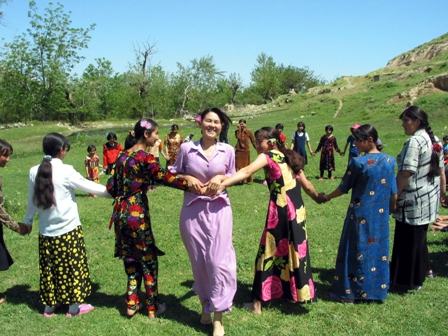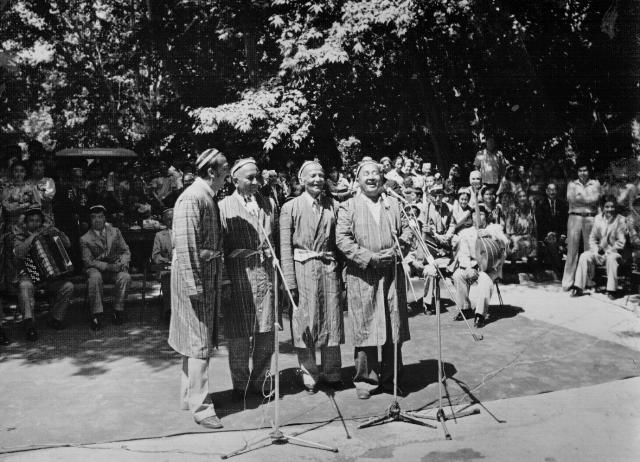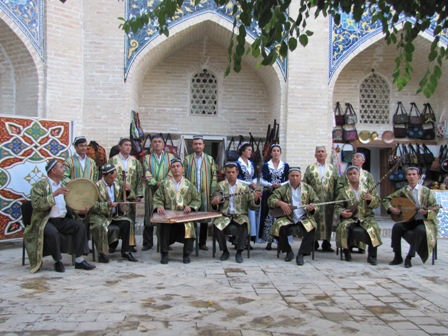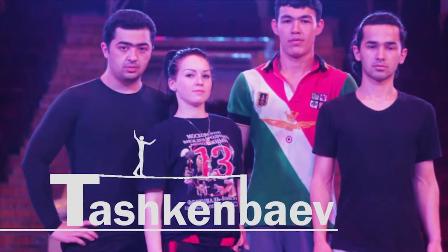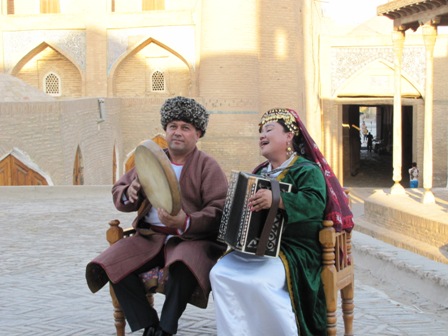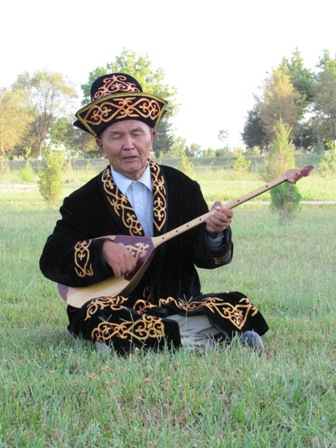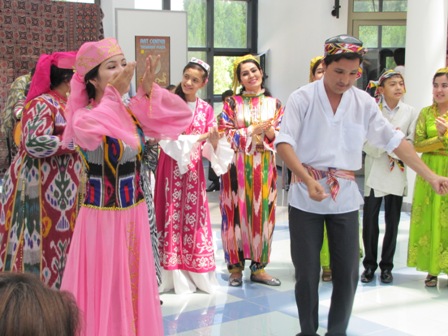Shashmaqom
- Details
March 24, 2015
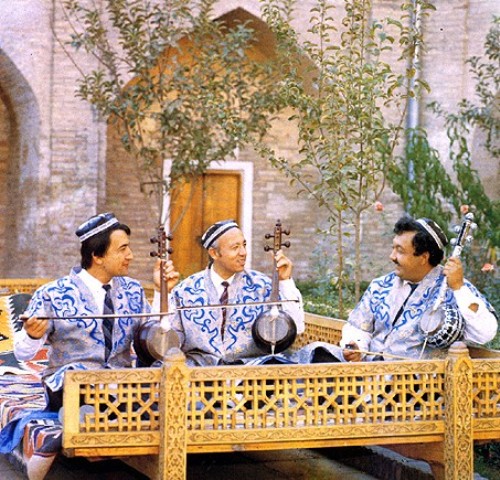
Shashmaqom got formed in the ХVIII century on the basis of system of 12 maqoms (or Duvozdakh maqom) and music traditions of Bukhara, which is considered one of the most ancient cultural centers of Central Asia.
Shashmaqom is a cycle consisting of six maqoms, namely Buzruk, Rost, Navo, Dugoh, Segoh and Iroq. Each of these consists of two parts respectively, i.e. instrumental one (which is called "Mushkilot") and vocal one (which is called "Nasr"), representing more than 250 cycles of instrumental and vocal compositions in total. Shashmaqom got formed in urban environment, and its bearers of traditions were well-known musicians and singers. Its vocal part was performed in Uzbek and Tajik languages. The texts were mainly taken from the poems of classics of oriental poetry (i.e. Rudaki, Jami, Lutfi, Navoi, Babur, Khafiz, Fizuli, Amiri, Nodira, Zebuniso, Ogahiy and others) and were dedicated to love-related, lyrical, philosophical, didactic, religious themes. Folk poetry examples were also used. Most widely used musical instrument was tanbur. It is based on tuning tanbur that the tonal basis of maqoms emerged. Instrumental part of each maqom included instrumental compositions such as "Tasnif", "Tarje", "Gardun", "Mukhammas" and "Sakil", performed either solo or by instrumental ensemble. However, each part differed with its own tune, character of melody, structure and usuls of doira. Vocal parts are considered the most difficult and complete ones in terms of structure, melos and form and are divided into two cycles (shuba): the first one includes "Sarakhbor", "Talqin", "Nasr" and "Ufar", performed by leading singer - hofiz (their melodies are more developed, of great range and complex form). Between main parts "Tarona" was sung by vocal ensemble as a connecting one (it is a small vocal piece, which has its own tunes, feature and forms). The second cycle (shuba) includes five-part cycles "Moghulcha" and "Savt" (except maqom "Iroq"). In addition to main parts, each maqom incorporates additional compositions: instrumental one (naghma, peshrav, samoyi, hafif), and vocal one (uzzol, ushshoq, bayot, chorgoh, nasrullo, oraz, khusayniy, navrozi sabo, khoro and ajam), the creators of which were bastakors (creators of oral musical tradition). Shashmaqom got formed, has been preserved, mastered and transmitted from generation to generation verbally, based on "Ustoz-shogird" ("master-apprentice") method of learning.
During the XVIII – beginning of the XX century Shashmaqom was a leading genre in court and urban culture (in Bukhara, Samarkand, etc.). The traditions of Shashmaqom were mastered in the beginning of the XX century at "Bukhara Oriental School" (1920) and Institute of Folk Music and Choreography in Samarkand (1928). For the first time Shashmaqom was recorded by Russian composer Viktor Uspensky in 1923 in Bukhara from famous masters Ota Jalol Nosirov, Ota Giyoz Abdughani. It was published in 1924 under the title of "Six musical poems. Shashmaqom". In the upcoming years Shashmaqom was recorded by B. Fayzullaev, F. Shakhobov and Sh. Sohibov ("Shashmaqom", a five-volume edition, Moscow, 1950-1961), Yunus Rajabiy ("Bukhara maqoms", Tashkent, 1959; "Shashmaqom", a six-volume edition, Tashkent, 1966-1975; "Uzbek maqoms. Shashmaqom", Tashkent: UNESCO, 2007), A. Babakhanov ("Shashmaqom", Berlin, 2010).
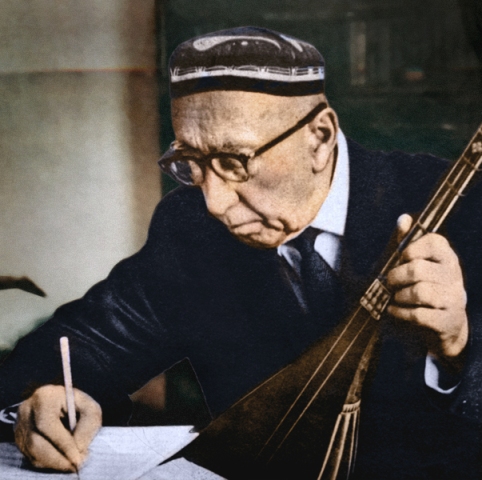 Starting from the ХХ century Shashmaqom was recorded and published in the form of separate collections, was scientifically studied and integrated in the new system of music education, and was actively used in composers' activities in Uzbekistan. In 1959 on the initiative of Yunus Rajabiy the first ever professional maqom ensemble was created under the auspices of Radio of Uzbekistan, which became an advocate and promoter of maqom art as well as a "school", bringing up new generation of musicians and singers, whose activity continues to present. Activities associated with awareness-raising and advocacy of Shashmaqom are conducted by professional and amateur maqom ensembles in Uzbekistan. Since 1975 competitions of amateur maqom ensembles and since 1983 - competitions of young maqom performers and ensembles have been conducted. In the last few years it became a tradition to organize International as well as Republican level competition of young performers of maqom art (2014-2015). The traditions of Shashmaqom were integrated into educational process of the Conservatoire, Institute of Art and Culture, Pedagogical Universities, colleges of music and academic lyceums, music schools. Among the bearers of Shashmaqom traditions it is possible to mention the following individuals: Ota Jalol Nosirov, Ota Ghiyoz Abdughani, Levi Babakhanov, Domla Khalim Ibadov, Yunus Rajabiy, Fakhriddin Sodiqov, Berta Davydova, Turghun Alimatov, Munojot Yolchieva, Olmas Rasulov and others. Among ensembles it is possible to mention maqom ensemble named after Y. Rajabiy, maqom ensemble of Bukhara Regional Philharmonic Society.
Starting from the ХХ century Shashmaqom was recorded and published in the form of separate collections, was scientifically studied and integrated in the new system of music education, and was actively used in composers' activities in Uzbekistan. In 1959 on the initiative of Yunus Rajabiy the first ever professional maqom ensemble was created under the auspices of Radio of Uzbekistan, which became an advocate and promoter of maqom art as well as a "school", bringing up new generation of musicians and singers, whose activity continues to present. Activities associated with awareness-raising and advocacy of Shashmaqom are conducted by professional and amateur maqom ensembles in Uzbekistan. Since 1975 competitions of amateur maqom ensembles and since 1983 - competitions of young maqom performers and ensembles have been conducted. In the last few years it became a tradition to organize International as well as Republican level competition of young performers of maqom art (2014-2015). The traditions of Shashmaqom were integrated into educational process of the Conservatoire, Institute of Art and Culture, Pedagogical Universities, colleges of music and academic lyceums, music schools. Among the bearers of Shashmaqom traditions it is possible to mention the following individuals: Ota Jalol Nosirov, Ota Ghiyoz Abdughani, Levi Babakhanov, Domla Khalim Ibadov, Yunus Rajabiy, Fakhriddin Sodiqov, Berta Davydova, Turghun Alimatov, Munojot Yolchieva, Olmas Rasulov and others. Among ensembles it is possible to mention maqom ensemble named after Y. Rajabiy, maqom ensemble of Bukhara Regional Philharmonic Society.
To safeguard Shashmaqom various studies are conducted, books and multi-volume editions are published, audio and video disks are produced, TV and Radio programmes are broadcasted, concerts such as "Maqom Evenings" and "Nazm va Navo" ("Poetry and Music") are organized in Uzbekistan. In addition, leading performers organize master classes and scientific conferences (Tashkent, 1975, 2014; Samarkand, 1978-1987, 2001-2007; Bukhara, 2013; Berlin, 2011-2013). In 2003 "The Music of Shashmaqom" was recognized by UNESCO as the "Masterpiece of Intangible Cultural Heritage of Humanity" and in 2008 was included in the Representative List of ICH of UNESCO (joint nomination by Uzbekistan and Tajikistan).












